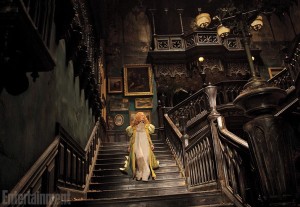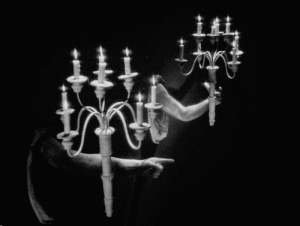
The other day, after watching Crimson Peak for the first time, I woke up with a fully-fleshed idea for a Gothic horror story about experience design. And while the story would take place in the past, it would really be about the future. Why? Because the future itself is Gothic.
First, what is Gothic? Gothic (or “the Gothic” if you’re in academia) is a Romantic mode of literature and art. It’s a backlash against the Enlightenment obsession with order and taxonomy. It’s a radical imposition of mystery on an increasingly mundane landscape. It’s the anticipatory dread of irrational behaviour in a seemingly rational world. But it’s also a mode that places significant weight on secrets — which, in an era of diminished privacy and ubiquitous surveillance, resonates ever more strongly.
Like the twenty-first century surveillance apparatus, the Gothic mode is preoccupied with that which is unseen. Hidden feelings, hidden histories, hidden staircases. Unspoken truths, secret plans, desires which dare not speak their own name. Gothic literature finds evidence of power or emotion sublimated “three hops” from the source. Rochester asks Jane to marry him, and lightning strikes a tree. Jane is sad, and the rain begins. It’s an inventory of emotional meta-data as evidenced by pathetic fallacy, presentiments of doom, inexplicable fevers, and twisted ankles.
So, how do we know the future is going in this direction?
I had my first inklings of this idea while reading the Institute for the Future’s anthology for the Age of Networked Matter project. I was part of it, but I didn’t get to read everybody else’s stories until they were all collated and I was on a flight to San Francisco to take part in an event related to them. Upon reading them, I emailed one of the authors and said: “Hey, I really liked all of these! Did you notice we all wrote horror stories?”
Because by and large, we had. With a couple of exceptions, all the stories in the anthology are haunted house stories. They were also science fiction prototypes. But they were haunted house stories. Why? Because the haunted house is how we will understand our homes, once the Internet takes over all our domestic touchpoints.
Consider the disappearance of the interface. As our devices become smaller and more intuitive, our need to see how they work in order to work them goes away. Buttons have transformed into icons, and icons into gestures. Soon gestures will likely transform into thoughts, with brainwave-triggers and implants quietly automating certain functions in the background of our lives. Once upon a time, we valued big hulking chunks of technology: rockets, cars, huge brushed-steel hi-fis set in ornate wood cabinets, thrumming computers whose output could heat an office, even odd little single-purpose kitchen widgets. Now what we want is to be Beauty in the Beast’s castle: making our wishes known to the household gods, and watching as the “automagic” takes care of us. From Siri to Cortana to Alexa, we are allowing our lives and livelihoods to become haunted by ghosts without shells.

Now, I’m not at all the only person to notice this particular trend (or, more accurately, to read the trend through this particular lens). It’s central to David Rose’s book Enchanted Objects, which you all should read. This is also why FutureEverything’s Haunted Machines symposium exists. Natalie Kane summarized it recently (and brilliantly) at the Lift 2016 conference in Geneva:
Now, it would be easy to characterize this particular future as simply “magical” or “animist.” A world in which everything is alive is a fairytale world, a world from myth or legend, wherein the careless treatment of a magic mirror (or a poisoned Apple) can alter the course of our lives. And a world of household spirits has deep roots in cultures outside the West. Is a “smart” home populated by multiple intelligences — some of them human — really so different from a home theoretically inhabited by yokai? Consider the nurikabe, a demon that is a sentient wall that refuses to budge. Or the mokumokuren, the haunted paper screen whose un-repaired holes and tears become eyes — one of our earliest models of in-home surveillance. Or, perhaps more familiarly, consider the kobolds and brownies and domovoi of Europe, the ambient household spirits who are mischievous or protective by turns, much like an insecure baby monitor.
So, what makes this future Gothic, as opposed to simply fantastical, or magical?
- Infrastructure is crumbling. Gothic literature is replete with strange locations at the intersection of time periods. In Gothic films, this manifests as crumbling manses, broken tombstones, and — consistently — the eradication of out-dated structures by fire. In an increasingly and invisibly connected world, this looks like the Internet of Shit. Quinn Norton put it best: everything is broken. Our infrastucture is decaying, vulnerable, and spooky.
- The position of women in society is changing. As Ellen Ledoux notes in this piece on the resurgence of Gothic tropes in cinema, “Where a young innocent women is in this large gothic space, threatened with things like rape and extortion or taking away property — you have Jane Eyre in 19th century, then Rebecca in the 20th century. These narratives seem to resonate even though women’s situations are different. They always track at moments women are pushing for change.” It is no accident that abortion clinics are closing all over the US just as Hillary Clinton is (vertiginously) poised to take the Democratic nomination, or that The Witch has us talking about the monstrous feminine again.
- That which has been repressed is returning. Freud spoke of the return of the repressed in his essay on the uncanny, in which a long-kept secret bursts forth like Madeline Usher clawing her way out of the tomb. But the idea of repression was core to his entire psychoanalytic approach. That approach has long since been debunked at the level of everyday psychoanalysis and therapy, but the ideas remain resonant at the level of literature and culture. (Freud was simply a better analyst of literature than of patients. Also, the patients paid better.) In any case, one of his ideas is that we are constantly battling against our primitive (by which he means childish, or formative) impulses, be they sexual or merely spiteful, in order to create and maintain the social fabric. But occasionally these impulses, long repressed, erupt into our daily lives with even greater force. I am, of course, speaking of Donald Trump, and how the GOP’s Southern Strategy made him possible. America has refused to deal with its legacy of plunder or make meaningful change to repair it — there are reams of Southern Gothic literature about this — and now one figure has harnessed the power of decades of unspoken hate and resentment, fuelling a rise to popularity so fast it would impress Randall Flagg.
Gothic literature is at the roots of the skeptical Scooby-Doo story, wherein events that might be supernatural are explained by, as Stephen King once called it, “pure human fuckery.” The Castle of Otranto is a classic example, and so is Jane Eyre. Crimson Peak, for all its howling spectres, is still closer to this tradition — one character is experiencing the narrative as a ghost story, while the others are living their lives in a late-Victorian noir worthy of Cornell Woolrich or Anthony Berkeley. It is, as the protagonist says of her own manuscript, “a story with ghosts in it.” The ghosts, while real, play a supporting role in helping the protagonist actualize herself, much in the same way that weak AI and algorithms help us become different versions of ourselves.
The important thing to remember about most Gothic stories, as we tiptoe down the darkened hallways of our Gothic future, is that they often have happy endings. Justice is served. The heroine survives, her eyes opened and her agency confirmed.
But first, the house must burn down.